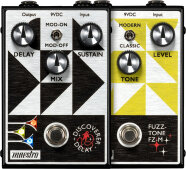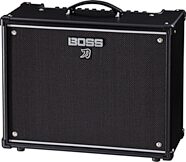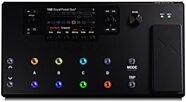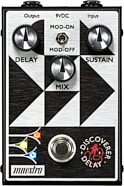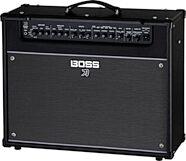Gibson Joan Jett Melody Maker Electric Guitar
No longer available at zZounds

zZounds Gear Experts Say...
Developed in close cooperation with Jett herself; features a lightweight, slab mahogany body with a Worn White finish.
Overview
"I got my Melody Maker in 1977," the legendary Joan Jett says about the guitar she has made one of the most iconic instruments in rock and roll. "It was light and it sounded great. It was the guitar I had in the Runaways and then played on all my hits, like 'I Love Rock N' Roll' and 'Bad Reputation' and 'Do You Wanna Touch Me.' It's my baby." Carefully developed in close cooperation with Jett herself, Gibson's Joan Jett Double Cutaway Melody Maker features a lightweight, slab mahogany body with a Worn White finish.
Angled, Classic Melody Maker Headstock
One of the Melody Maker's more distinguishable features is its smaller, angled headstock, which lacks the traditional mahogany wing blocks typical of other Gibson models. But like every Gibson, the Joan Jett Melody Maker headstock is carved out of the same piece of mahogany as the neck and carefully angled at 17 degrees. It is not a "glued-on" headstock, and the process takes craftsmanship, time, and effort. But the rewards are worth the effort. The angled headstock increases pressure on the strings to help them stay in the nut slots, and prevents loss of string vibration between the nut and the tuners, which equals better sustain.
Custom Designed Slim-Tapered Neck Profile
The majority of the necks on Gibson's famed Melody Makers from the late 1950s and into the 1960s featured Gibson's traditional rounded profile--the same neck profile found on many of the iconic 1958 and 1959 Les Paul Standards. The neck profile on the Joan… read more Jett Melody Maker, however, is crafted to the same specs as Jett's original guitar--a slim-taper profile similar to the Les Pauls and SGs of the mid to late 1960s. Add Gibson's Worn White finish to the back of the neck and the Joan Jett Melody Maker neck is one of the Gibson's most comfortable and playable.
Slim, Double Cutaway Mahogany Body
From its initial launch in 1959, the Melody Maker was known for its single-cutaway design similar in profile to Gibson's iconic Les Paul Standard. The double cutaway design on the Joan Jett Melody Maker was first introduced in 1962, then changed again in 1966 to a style similar to the legendary Gibson SG, with pointed horns and beveled edges. The Joan Jett Melody Maker body is made from premium mahogany, which goes through the same rigorous selection process as all of Gibson's woods. Once inside the Gibson factories, the wood is dried to a level of "equilibrium," where the moisture content does not change during the manufacturing process. This guarantees tight-fitting joints and no expansion, and controls the shrinkage and warping of the woods, in addition to reducing the weight. It also improves the woods' machinability and finishing properties. Consistent moisture content means that every Joan Jett Melody Maker will respond evenly to temperature and humidity changes long after it leaves the factory.
Single Gibson Burstbucker 3 Zebra Humbucker
Gibson USA's Joan Jett Double Cutaway Melody Maker features a single Gibson Burstbucker 3 humbucker that captures the raw punch and power of the rare Velvet Hammer aftermarket humbucker on Jett's original guitar. The Burstbucker 3 debuted in 1990, and represents Gibson's drive to capture and recreate the characteristics of the vintage "Patent Applied For" humbuckers of the late 1950s. The earliest Gibson PAF humbuckers were wound using imprecise machines, resulting in pickups with varying degrees of output and tone, and the Burstbucker line represents those variations but with some modern appointments. The Burstbucker 3 provides historically accurate PAF tone with two slightly overwound coils, creating a raw, airy tone packed with enough power and punch to cut through any mix.
Worn White Finish
Applying a satin nitrocellulose finish to any Gibson guitar--including the Joan Jett Melody Maker--is one of the most labor-intensive elements of the guitar-making process, yielding some very satisfying results. This unique finish gives the Joan Jett Melody Maker the look and feel of a truly vintage guitar, also making it extremely playable and comfortable. A properly applied nitro finish requires extensive man hours, several evenly applied coats, and an exorbitant amount of drying time. But this fact has never swayed Gibson into changing this time-tested method, employed ever since the first Gibson guitar was swathed with lacquer back in 1894. Why? For starters, a nitro finish dries to a much thinner coat than a polyurethane finish, which means there is less interference with the natural vibration of the instrument, allowing for a purer tone. A nitro finish is also a softer finish, which makes it easily repairable and allows the wood to breathe and age properly over time.
"Kill" Toggle Switch
With only one pickup, the Joan Jett Double Cutaway Melody Maker features a 'Kill' toggle switch, which effectively switches between the hot signal from the pickup and the ground signal, successfully 'killing,' or turning off the signal from the pickup when activated. Jett uses this control to shut off her guitar when singing and not playing, or as an effect during a song.
Grover Les Paul-style Mini Tuners
These classic, innovative tuners offer the same design and ease of use as the original tuners on Gibson's Melody Makers from the early 1960s. The smaller buttons afford more space for the fingers to tune the strings, the tuner housing is completely sealed, and a gear ratio of 14:1 delivers excellent performance and tuning accuracy to match the vintage Les Paul look.
Witch Hat Knobs
Many of Gibson's legendary guitars of the 1950s and 1960s featured black "witch hat" control knobs with silver tops. The Joan Jett Melody Maker pays tribute to that era with these period-correct knobs.
Period-Correct Pickguard
The black vinyl pickguard dates back to the early double cutaway Melody Makers of the early 1960s, and is an exact reproduction of the pickguard on Jett's original Melody Maker, offering both a distinct look and complete protection for the model's select mahogany body. read less
Angled, Classic Melody Maker Headstock
One of the Melody Maker's more distinguishable features is its smaller, angled headstock, which lacks the traditional mahogany wing blocks typical of other Gibson models. But like every Gibson, the Joan Jett Melody Maker headstock is carved out of the same piece of mahogany as the neck and carefully angled at 17 degrees. It is not a "glued-on" headstock, and the process takes craftsmanship, time, and effort. But the rewards are worth the effort. The angled headstock increases pressure on the strings to help them stay in the nut slots, and prevents loss of string vibration between the nut and the tuners, which equals better sustain.
Custom Designed Slim-Tapered Neck Profile
The majority of the necks on Gibson's famed Melody Makers from the late 1950s and into the 1960s featured Gibson's traditional rounded profile--the same neck profile found on many of the iconic 1958 and 1959 Les Paul Standards. The neck profile on the Joan… read more Jett Melody Maker, however, is crafted to the same specs as Jett's original guitar--a slim-taper profile similar to the Les Pauls and SGs of the mid to late 1960s. Add Gibson's Worn White finish to the back of the neck and the Joan Jett Melody Maker neck is one of the Gibson's most comfortable and playable.
Slim, Double Cutaway Mahogany Body
From its initial launch in 1959, the Melody Maker was known for its single-cutaway design similar in profile to Gibson's iconic Les Paul Standard. The double cutaway design on the Joan Jett Melody Maker was first introduced in 1962, then changed again in 1966 to a style similar to the legendary Gibson SG, with pointed horns and beveled edges. The Joan Jett Melody Maker body is made from premium mahogany, which goes through the same rigorous selection process as all of Gibson's woods. Once inside the Gibson factories, the wood is dried to a level of "equilibrium," where the moisture content does not change during the manufacturing process. This guarantees tight-fitting joints and no expansion, and controls the shrinkage and warping of the woods, in addition to reducing the weight. It also improves the woods' machinability and finishing properties. Consistent moisture content means that every Joan Jett Melody Maker will respond evenly to temperature and humidity changes long after it leaves the factory.
Single Gibson Burstbucker 3 Zebra Humbucker
Gibson USA's Joan Jett Double Cutaway Melody Maker features a single Gibson Burstbucker 3 humbucker that captures the raw punch and power of the rare Velvet Hammer aftermarket humbucker on Jett's original guitar. The Burstbucker 3 debuted in 1990, and represents Gibson's drive to capture and recreate the characteristics of the vintage "Patent Applied For" humbuckers of the late 1950s. The earliest Gibson PAF humbuckers were wound using imprecise machines, resulting in pickups with varying degrees of output and tone, and the Burstbucker line represents those variations but with some modern appointments. The Burstbucker 3 provides historically accurate PAF tone with two slightly overwound coils, creating a raw, airy tone packed with enough power and punch to cut through any mix.
Worn White Finish
Applying a satin nitrocellulose finish to any Gibson guitar--including the Joan Jett Melody Maker--is one of the most labor-intensive elements of the guitar-making process, yielding some very satisfying results. This unique finish gives the Joan Jett Melody Maker the look and feel of a truly vintage guitar, also making it extremely playable and comfortable. A properly applied nitro finish requires extensive man hours, several evenly applied coats, and an exorbitant amount of drying time. But this fact has never swayed Gibson into changing this time-tested method, employed ever since the first Gibson guitar was swathed with lacquer back in 1894. Why? For starters, a nitro finish dries to a much thinner coat than a polyurethane finish, which means there is less interference with the natural vibration of the instrument, allowing for a purer tone. A nitro finish is also a softer finish, which makes it easily repairable and allows the wood to breathe and age properly over time.
"Kill" Toggle Switch
With only one pickup, the Joan Jett Double Cutaway Melody Maker features a 'Kill' toggle switch, which effectively switches between the hot signal from the pickup and the ground signal, successfully 'killing,' or turning off the signal from the pickup when activated. Jett uses this control to shut off her guitar when singing and not playing, or as an effect during a song.
Grover Les Paul-style Mini Tuners
These classic, innovative tuners offer the same design and ease of use as the original tuners on Gibson's Melody Makers from the early 1960s. The smaller buttons afford more space for the fingers to tune the strings, the tuner housing is completely sealed, and a gear ratio of 14:1 delivers excellent performance and tuning accuracy to match the vintage Les Paul look.
Witch Hat Knobs
Many of Gibson's legendary guitars of the 1950s and 1960s featured black "witch hat" control knobs with silver tops. The Joan Jett Melody Maker pays tribute to that era with these period-correct knobs.
Period-Correct Pickguard
The black vinyl pickguard dates back to the early double cutaway Melody Makers of the early 1960s, and is an exact reproduction of the pickguard on Jett's original Melody Maker, offering both a distinct look and complete protection for the model's select mahogany body. read less
Specs
Specifications
Body Style: Double Cutaway
Body Species: Mahogany
Plating Finish: Chrome
Tailpiece: Gibson Stop Bar
Bridge: Gibson Tune-O-Matic
Tuners: Mini Grovers
Bridge Pickup: Zebra Burstbucker 3
Pickup Cover: No
Controls: 1 Tone, 1 Volume
Control Knobs: Black Witch Hat
Special Features: Kill Switch
Neck Species: Mahogany
Nut: Corian
Nut Width: Standard Gibson: 1.695" +/- .050"
Silkscreen: Gibson Logo
Truss Rod: Gibson Adjustable Truss Rod
Truss Rod Cover: Artist's Signature Truss Rod Cover
Fingerboard Binding: Ebony
Inlays: Acrylic Dot
Number of Frets: 22
Scale Length: 24 - 3/4 in.
Case Type: Gibson Hardshell
Interior: White
Case Exterior: Black
Silkscreen: Gibson USA Logo
Body Style: Double Cutaway
Body Species: Mahogany
Plating Finish: Chrome
Tailpiece: Gibson Stop Bar
Bridge: Gibson Tune-O-Matic
Tuners: Mini Grovers
Bridge Pickup: Zebra Burstbucker 3
Pickup Cover: No
Controls: 1 Tone, 1 Volume
Control Knobs: Black Witch Hat
Special Features: Kill Switch
Neck Species: Mahogany
Nut: Corian
Nut Width: Standard Gibson: 1.695" +/- .050"
Silkscreen: Gibson Logo
Truss Rod: Gibson Adjustable Truss Rod
Truss Rod Cover: Artist's Signature Truss Rod Cover
Fingerboard Binding: Ebony
Inlays: Acrylic Dot
Number of Frets: 22
Scale Length: 24 - 3/4 in.
Case Type: Gibson Hardshell
Interior: White
Case Exterior: Black
Silkscreen: Gibson USA Logo
No longer available at zZounds
In most cases, a product is unavailable because it has been discontinued by the manufacturer
This is a carousel with product cards. Use the previous and next buttons to navigate.


